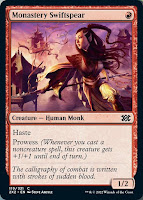The next Magic set- Double Masters 2022- is soon upon us. This reprint set features an astonishing 69 cards whose rarity has shifted. This post looks at that concept. But first, some background.
In Magic, there are four rarity levels: common, uncommon, rare, and mythic rare. In most expansions, the rarity is indicated by color of the expansion symbol (black, silver, gold, or orange). These rarities indicate:
- prevalence of distribution
- power level (generally)
- legal cards for the pauper format
Prevalence of distribution used to be straightforward. A booster pack (back when there was just one kind) had 11 commons, 3 uncommons, and 1 rare or mythic rare, with mythic rares appearing in 12.5% of packs. (Today, set and collector booster packs have different distributions, with proportionally more uncommons and rares/mythic rares appearing, but I won't get into that here.)
Power level generally increases as rarity increases. So a mythic rare will probably be more powerful than a common, in terms of cost/benefit ratio. That said, power level is different than synergy and popularity- so there are many staple commons/uncommons that are featured in competitive decks, and some mythic rares never see play. Again, another topic for another time.
Legal cards for pauper is straightforward: pauper may include any cards that were ever printed at the common rarity.
That was all background; on to today's subject.
In Magic, a rarity shift is where a card is reprinted at a different rarity level than a previous iteration. It could go either direction- a rare may be reprinted as an uncommon, a common may be reprinted as an uncommon, etc. Take Serra Angel, for example. It was initially printed as a rare, but has since been reprinted as an uncommon:
Why would Wizards change the rarity of a card? I see four reasons:- Power creep
- Correction based on power level
- Pauper legality
- Special releases
Power creep is the tendency of the game to produce comparably more powerful cards for the same rarity & cost. It's the opposite of inflation, in a way- the same mana cost will tend to buy you more capability over time. That needs a separate post to explore in more detail. For today's purposes, it suffices to say that this is one cause of rarity shift. No experienced Magic player today would look at a Serra Angel and say 'wow, that is so powerful.' Uncommon is a suitable rarity based on its power level in today's environment. But back when the game began, it was an amazing card. Rare was appropriate at that time. Power creep rarity shifts go one direction: from higher rarity to lower rarity. In most cases, shifts go down one level, but occasionally, you see a card jump two.
Correction based on power level is related to power creep but can accommodate cards going the other direction- from lower rarity to higher, e.g. from uncommon to rare. In this case, Wizards printed a card at one rarity that they since realized is just too powerful (or weak) for that level. Consider Dockside Extortionist, who will see its rarity jump from rare to mythic in the new set:
Pauper legality is related to power creep, but has an additional nuance: changing a card's rarity to common means that a card can be included in the pauper format. In this forthcoming set, 26 cards are now printed at the common level what were previously printed as uncommons (or, in a few cases, rares). Pauper players are all over Monastery Swiftspear in particular, a card that will undoubtedly become a staple in that format:
The final reasons is special releases. Things like Secret Lair Drops, Commander Collections, or From the Vault releases routinely display cards as rare or mythic, even if their previous printings were much lower. In this case, the rarity shift is to denote the uniqueness of the version itself, and not the power level. Back to Serra Angel as an example, showing a mythic rarity in its From the Vault printing:
With over 20,000 unique cards printed to date, and 11,200 of those getting reprints, it doesn't surprise me that there would be rarity shifts. According to a search in Scryfall, over 1,400 cards have seen such shifts. But that includes Secret Lair Drops and From the Vault changes . .. omitting those still leaves 1,389 shifted cards. I'll have to verify my syntax is correct in each of these cases . . . I think there are other special releases I did not exclude. But it's significant enough to note.
For the novice, these things can be daunting. Ultimately, this is something you can ignore most of the time. The main thing to note is in pauper: a player may include cards printed at whatever rarity so long as they had one printing at the common level.










